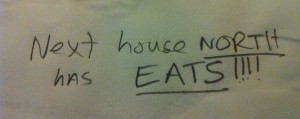
An ‘Easy Mark’
To call someone an “easy mark” is normally not a compliment. We use it in the context of taking advantage of someone and associate it with weakness. I have a story that explains the term’s origin. I’ll let you—the reader—decide if being an easy mark is a compliment or not.
Thanksgiving and then Christmas are good times to think about the “G words” of gratitude and generosity. They’re two of the best words in the English dictionary. Here’s the story that describes those words in action:
The Great Depression of the 1930’s was a traumatic time in our nation’s history. This is evidenced by how deeply affected those who lived through were. My grandfather would sadly shake his head as he gravely described the challenges of supporting a young family during that tough decade.
During these hard years, families and individuals were uprooted and roamed the country desperate for work. My mother, who was a young child during this time, told of sitting at the window of a moving train and seeing a hobo, hanging onto the side of her car, nodding his head as he passed by.
Most hoboes were single men riding the rails looking for work. As the slowing trains neared a station, the hoboes would jump off and find the nearby gathering places called “hobo jungles.”
A story is told of an older woman who lived along the tracks in a small Midwestern town. Although alone and poor, this woman had a reputation for giving food to anyone in need. In the language of hoboes, she was an “easy mark.”
Hoboes, using a piece of chalk or coal, would mark the gatepost or nearby fences of homes where handouts were readily available. This woman’s gatepost was well decorated with a large X. She was used to the knocks at her back door, and actually looked forward to the opportunity to share, even though what she had was meager.
One winter, just before Christmas, a strong storm blew through her town. The pelting rain seemed to be coming down sideways, and it soon turned to snow as conditions deteriorated.
The woman watched through her window as the slowing trains passed and wet hoboes jumped off, trotting toward shelter from the storm. However, to her surprise and dismay, all of them passed by her gate, oblivious to the cups of hot soup awaiting them.
This disturbed her greatly as she watched the nearby tracks. When another group of men struggled by without stopping, she grabbed her umbrella and stepped out into the cold rain.
At her gatepost, holding her umbrella with one hand, she pulled out a piece of chalk and re-sketched her X where the rain had washed it off the post. Stepping back, seemingly satisfied that her “easy mark” was visible again, she returned to the house, wet but ready—ready and happy to greet the men who soon began coming through the gate to her door.

I love that story because I grew up in the home of “an easy mark.” His name was Clayton Iles, and he was my beloved father. Both of my parents modeled kindness and generosity toward others, but Daddy turned it into an art form. He was a true easy mark—always ready to give a helping hand.
Although not rich materially, he willingly made small “loans” to folks. Due to his being known as an easy mark, needy families came to him. And he helped willingly and without any expectation of repayment—which was good because repayment seldom came. He considered it a “gift” instead of a loan.
When he died, I stood by his casket for four straight hours as a long line of friends and neighbors snaked out of the funeral home and out into the street. Many leaned in and whispered about specific things Daddy had done for them in the past—acts of kindness and compassion.
At Southern funerals and wakes, we use the term “we’ve come to pay our respects.” That long line of mourners was Daddy’s repayment on his giving—respect mixed with love. He chose to invest his life in others and it paid great dividends in the joy and friendship he received in return.
Beside his grave at Dry Creek Cemetery are several items: an old softball, a horseshoe, a pinecone—all testaments to the things he loved. Engraved on his grave marker is the verse that was also engraved on his heart—the very words of Jesus in Matthew 25:
“. . . For I was hungry and you gave me food; I was thirsty and you gave me drink I was a stranger and you took me in; I was naked and you clothed me; I was sick and you visited me; I was in prison and you came to me. . . . Assuredly, I say to you, inasmuch as you did it to one of the least of these my brethren, you did it to me.”
That was his ‘easy mark’ verse. He viewed it as a commandment from his Savior and lived by it daily. Now I’m a long ways from being the man of generosity that my dad was, but I’m still working on it. I’m going to work on it extra hard during this Christmas season.
Yes, Thanksgiving and Christmas are times when we remember it’s better to give than to receive. A time to live with gratitude for the “easy marks” that show up on gateposts, in hearts, and in generous deeds.
 Creekbank Stories Curt Iles, Storyteller
Creekbank Stories Curt Iles, Storyteller
